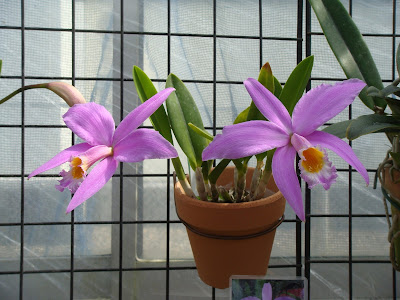Laelia jongheana is native to Brazil. This very rare species is found on the eastern slopes of Pico do Itambé in the central part of Minas Gerais at an altitude of 1300-1600 m...
Laelia jongheana also called as The Jonghe Laelia, Bletia jongheana, Cattleya jongheana, Hadrolaelia jongheana, Sophronitis jongheana, is a species of the genus Laelia. This species was described by Heinrich Gustav Reichenbach in 1872.
IDENTIFY LAELIA JONGHEANA
Laelia jongheana is native to Brazil. This very rare species is found on the eastern slopes of Pico do Itambé in the central part of Minas Gerais at an altitude of 1300-1600 m. The plants occur on trees growing on the bottoms of steep-wall steep. Even in the dry season, there are at least some oozing water in these steams.
It is a miniature, cool growing epiphytic species, which reaching 10-17 cm in height, with ovoid to ellipsoid, dark green, sulcate, 3.0-5.5 cm long and about 1.5 cm width pseudobulbs subtended by a white, apressed sheath and carrying a single, apical, very leathery, oblong-elliptic, obtuse or emarginated, 8-12 cm long and 3 cm wide leaf.
The Jonghe Laelia blooms in the late winter till spring on a 5 3/4" (14 cm) long raceme with 1 or 2 long-lived flowers. The flowers are 10-16 cm in diameter and are large in relation to the size of the whole plant. The flakes of both whorls are widely spread, with a pronounced texture and are almost flat. The color changes from medium to dark pink or pink purple. The outer whorls are narrowed with sharp tips, and the inner whorl petals, almost twice as wide as the outer whorl flakes, have a nearly rhombic shape and wavy edges near the tops. The lip is almost 5.5 cm long and is directed downwards. It is usually pale lilac on the outside and gold and orange on the inside. Very large side plots wrap up and inwards and touch over the spine to form a long tube that covers the rod.
LAELIA JONGHEANA CARE AND CULTURE
Cultural information should only be used as a guide, and should be to be adapted to suit you. Your physical location; where you grow your plants, how much time you have to devote to their care, and many other factors, will need to be taken into account. Only then can you decide on the cultural methods that best suit you and your plants.
Light:
Laelia jongheana needs a light level of 30000-45000 lux. The light should be slightly filtered or dispersed, and the plants should not be exposed to the direct sunlight of the midday sun. The light should be kept as high as possible, so as not to burn the leaves. The plants need constant, strong air movement, especially those growing at high levels of light.
Temperature:
It is a plant with moderate thermal requirements. In summer, the average day temperature is 23-25 ° C, at night 15-16 ° C, with a daily amplitude of 8-10 ° C. In winter, the average daytime temperatures are 19-22 ° C and the night 10-11 ° C, with a daily amplitude of 9-11 ° C.
Humidity:
The Jonghe Laelia needs the humidity of about 80% for most of the year, but in winter and early spring, it falls to around 70-75%.
Substrate, growing media and repotting:
Laelia jongheana grow well attached to pieces of tree ferns, if you can provide high humidity, and during the summer they will be irrigated at least once a day. In the period of extremely hot and dry weather, attached plants may require even several waterings during the day.
They can also grow in small pots or baskets filled with a very thick, loose, quickly drying base that allows the roots to dry quickly after watering. The best pots are sufficient for room growth for 1-2 years. The substrate in larger pots for too long maintains the moisture around the roots after watering, which can lead to their rotting. It is recommend bark with medium or high gradation, to which you can mix perlite and medium or large pieces of charcoal.
Repotting or dividing plants should be done when the growth of new roots begins.
Watering:
Laelia jongheana should often be watered during active growth from spring to autumn, but the roots must always dry quickly after watering. When new growths reach maturity in the autumn, the amount of water should be gradually reduced.
Fertilizer:
During the active growth of the plants should be fertilized every week 1/4-1/2 of the recommended dose of fertilizer for orchids. A fertilizer with a high nitrogen content is beneficial from spring to mid-summer, and a phosphorus-rich fertilizer can be used in late summer and autumn.
Rest period:
In winter, Laelia jongheana have lower requirements for the amount of water, but the substrate should not completely dry out. In most cases, adequate humidity will ensure morning misting occasionally between uncommon watering. Watering can be slightly increased if the leaves or pseudobulbs show excessive wrinkling. Fertilization should be eliminated until spring, when waterings resumes.















COMMENTS